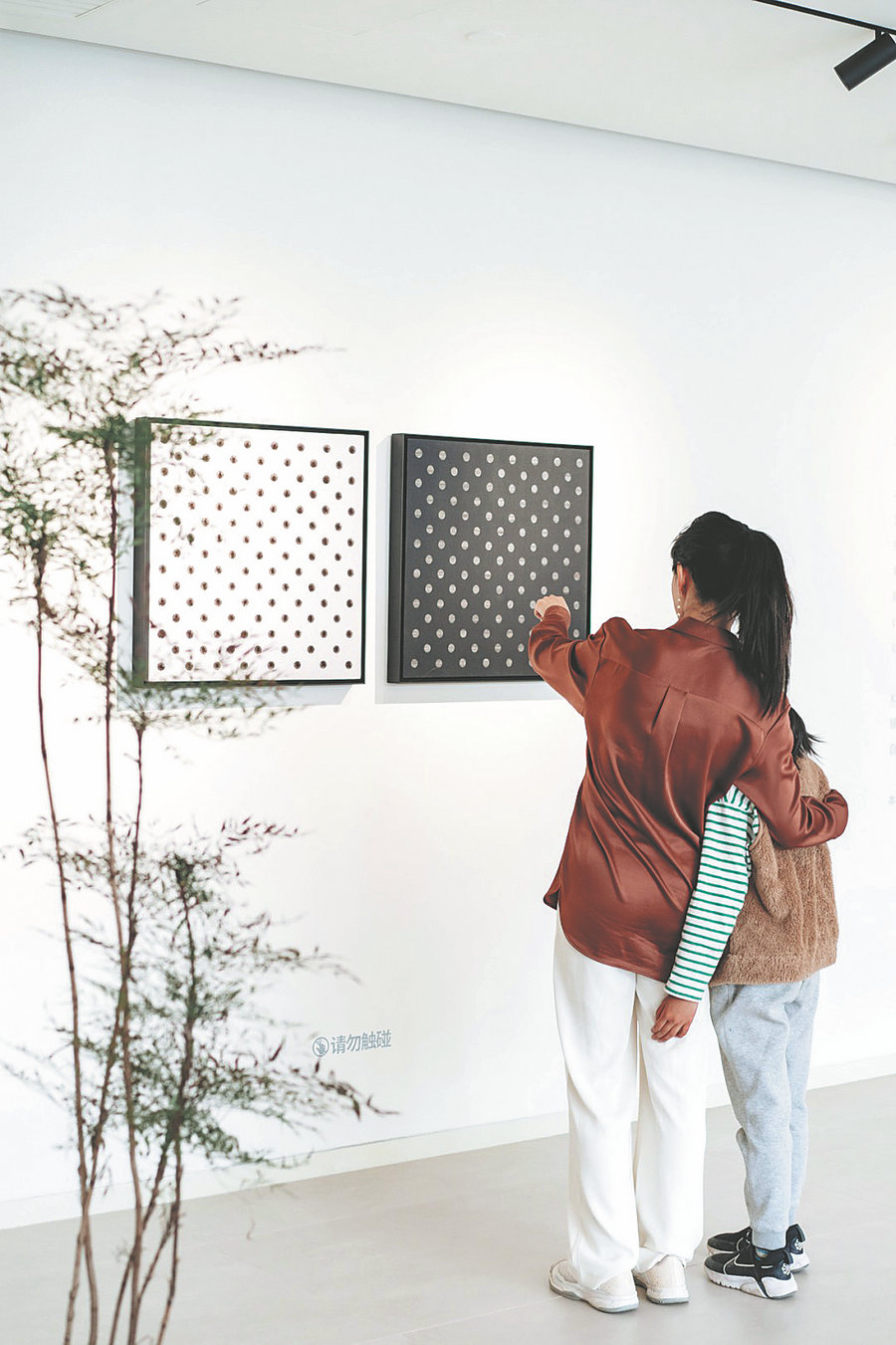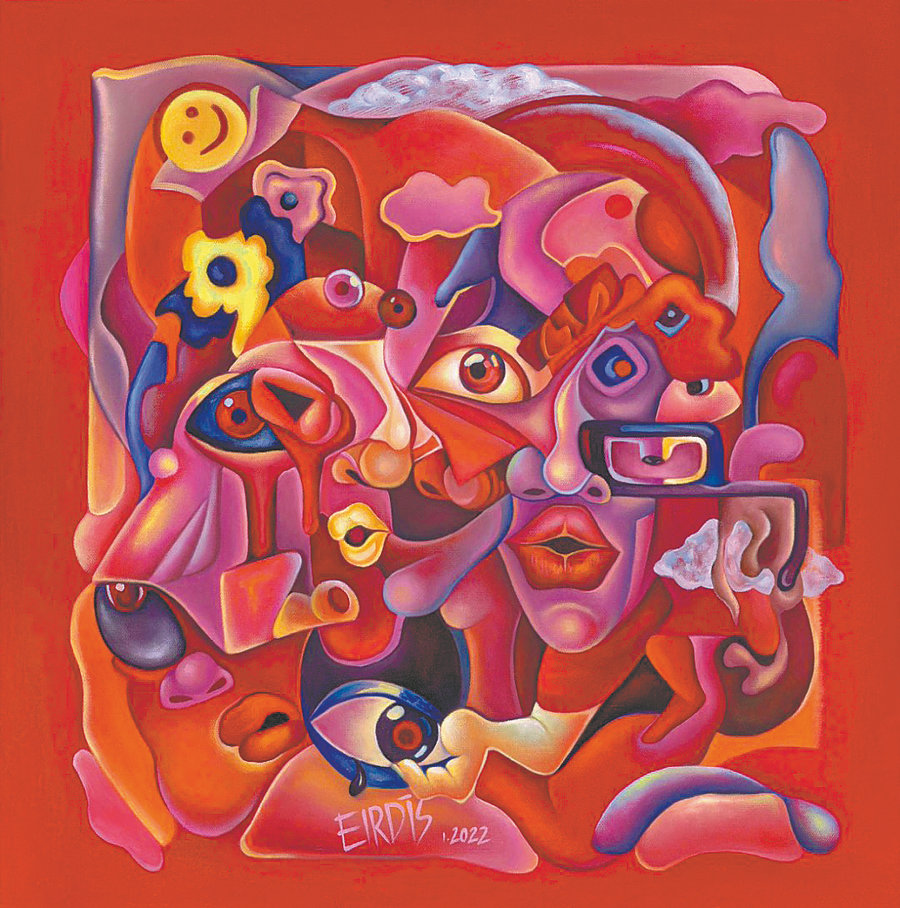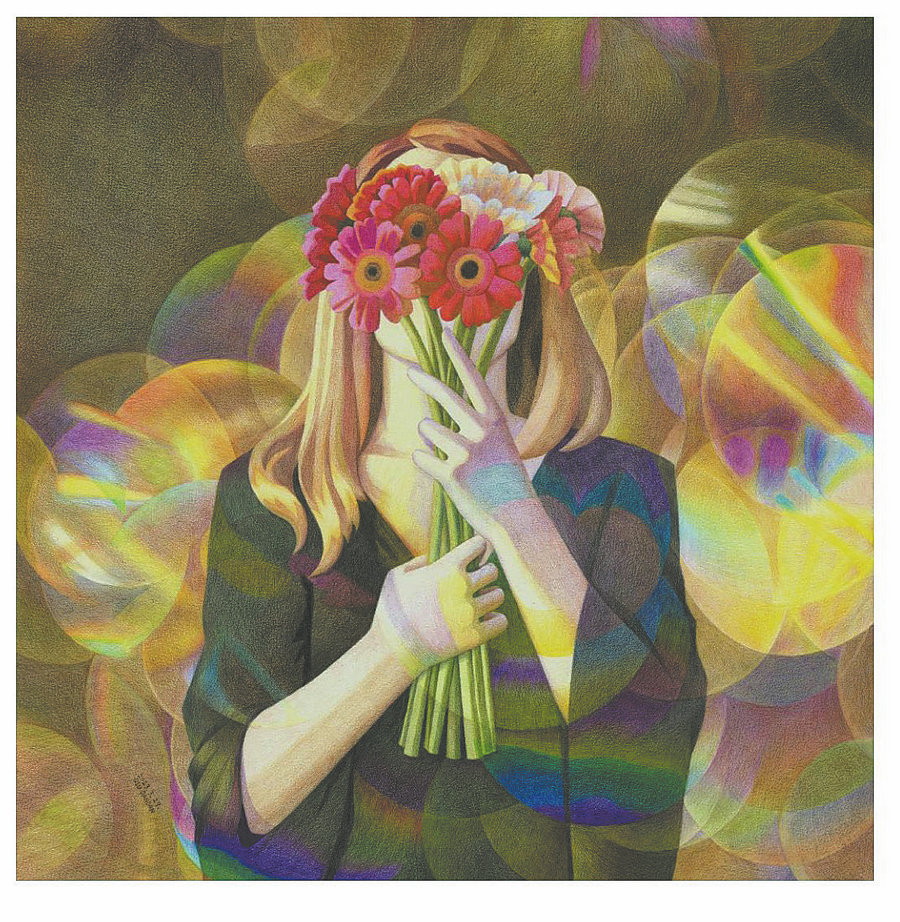Framing a new look at womanhood

Polka Dot-white and Polka Dot-black are jointly created by Cai Yaling and her mother with their hair. [Photo provided to China Daily]
A new artistic hub, Empty Space, has been established in the Wudaoying Hutong of Beijing. Its inaugural exhibition features works from six female artists, which serve as a powerful reflection of the deep exploration and expression undertaken by them in their quest for understanding and self-awakening.
After six months of planning, the exhibition The World of XX, in which "XX" refers to the female sex chromosome, successfully builds a dialogue about artists' personal experiences, self-observation, inner thoughts, vulnerabilities and courage.
The exploration and expression of the female self, body and psychological experience has been a constant pursuit for Cai Yaling. The artworks, Polka Dot-white and Polka Dotblack, were created together with her mother.
In Polka Dot-white, she sewed strands of her mother's hair onto a black cloth in the form of polka dots. Conversely, her mother, using Cai's naturally shed black hair, created another artwork in a slightly folkloric style. Although both artworks adopt the polka dot form, they evoke entirely different feelings when presented.
From a distance, these two pieces may appear as mere fabric, but upon closer inspection, one can sense the emotional exchange between two generations.
"In that period of time, I reacquainted myself with my mother's imperfections from the perspective of an independent woman, and I realized how deeply she had influenced me," says Cai. "Hair became the observer, and the process of communication between my mother and me became the true artwork."

A piece of Eirdis Ragnarsdottir's series artwork Lost and Found, in which she visualizes her meditation practices. [Photo provided to China Daily]
Eirdis Ragnarsdottir, a Chinese-Icelandic artist who grew up in a culturally diverse background, has been grappling with issues of identity from an early age. Through her artistic creations, she has embarked on a journey of self-discovery and the reconstruction of her own ontological symbols.
Her artwork, Lost and Found, is a series of paintings in which the artist visualizes her meditation practices. Guided by subconscious intuition, Ragnarsdottir deconstructs her dialectical understanding of self and the universe into symbolic representations. Incomplete body images, such as eyes, mouths and limbs, as well as fragmented depictions of natural elements like clouds, skies and flowers, are reconstructed within her compositions.
"As a mixed-blood individual, I am inherently different from those around me, and people always perceive me as different based on my appearance. This holds true both in Iceland and in China. I seem to belong to them, yet I also feel that I don't fully belong," Ragnarsdottir claims.

Du Meng's glass artwork. [Photo provided to China Daily]
Glass serves as both the medium of creation and the means through which the artist engages in a dialogue with the world and connects with others. Du Meng, an artist whose primary medium is glass, creates reflective and embedded glass artworks that fuse clarity and transparency with delicate and resilient emotions, linking viewers and the world.
Du sees that the optical effect of mirrors is in stark contrast to the glass. While a mirror reflects one's own image, it fails to penetrate the world behind it. In the infinite expanse of time, light permeates everything, passing through glass and reflecting back from mirrors.
"The meaning of glass lies in its nonexistence. We cautiously observe the changes around us, while also being constantly observed by everything around us," Du states.
Mu Chenyang herself is uncertain whether her work Me and My Unreliable Friends: Soul Station can be defined as an art piece. Individually named knitted hats, each with its unique form, serve as reflections of her life and materializations of her emotions. She connects personal experiences with sensory perception, highly sensitive personality traits and academic research. Combining her interest in materials and interaction, she contemplates the power of emotions and feelings.
"They are the little surprises in the 'main melody' of my life, the small means of escaping unhappiness. Each hat seems to have its unique soul and emotions, and when I wear them, I feel a surge of strength and courage," Mu reveals.
The sense of power subtly emanating from Qiu Dandan's paintings stems from the artist's solitary moments. In the painting, a female figure stands in bubblelike halos of light, with her face concealed by a bouquet of flowers.
Qiu says: "The process of depicting and creating art itself serves as a practice of self-cultivation, an exploration of the inner self, and a realization of one's state of mind. And that tells the meaning of loneliness."

Using female figures as her recurring subject, Wang Xiaoshuang's artwork captures the memories and life experiences of urban women. [Photo provided to China Daily]
Using female figures as her recurring subject, Wang Xiaoshuang's artwork captures the youthful memories and life experiences of successive generations of urban women, employing her unique artistic language.
Her latest creations portray full and serene female figures, serving as vivid depictions of contemporary urban women and scenes of consumer society. They also visually manifest the artist's personal thoughts and emotions within the artwork.
Wang explains: "We live in the city, amid the hustle and bustle, with crowds of people flowing by. The relationships among women can be intimate yet delicate. I have no expectations because the outcome of connection depends on the individual rather than their gender. Differences certainly exist, as understanding changes one's perception of many things."
At the exhibition scene, several immersive and interactive art therapy installations are set up throughout the venue. For instance, at the entrance, there is a scent installation that guides viewers to experience three healing aromas from morning to midnight — the flowing water, the whispering forest and the silently blooming flowers.
Furthermore, there is a special space dedicated to everyone called the Pool of Souls. Here, viewers can use the provided droppers to select a pigment and drop it into any transparent container.

One of Qiu Dandan's paintings reveals the artist's sense of power during solitary moments. [Photo provided to China Daily]
These immersive and interactive art therapy installations aim to create a transformative and healing experience for the visitors. By engaging multiple senses and allowing personal expression, the installations encourage self-reflection, relaxation and emotional connection. They provide a sanctuary within the exhibition, where individuals can immerse themselves in a moment of introspection and find solace in their own unique journey of self-discovery and healing.

Polka Dot-white and Polka Dot-black are jointly created by Cai Yaling and her mother with their hair. [Photo provided to China Daily]
The Empty Space was established by six women, who come from diverse backgrounds, including art, fashion, media, and the consumer sector. They prefer to be identified by single names.
Xianer, the main founder, gathered her sister, schoolmates and friends she has known since childhood, and together gave birth to the space. "I found them, and they, in turn, helped me discover a truer version of myself," she says.
They all have their own anxieties and concerns in life, she says. Some are worried about late childbearing, some are stressed about raising children, and some are overwhelmed by work. However, they are all deeply healed by the process of curating the exhibition and the artworks presented.
Lucy, one of the co-founders of the art space, claims that, at different hours on the day of the opening ceremony, she and her mother both chose the same container on the wall, and picked the pigment in the same color at the Pool of Souls. "In that fleeting moment, tears welled up in my eyes. I felt the connection with my mother," she says. "You can be an adult in the wild world, yet still be a child in need of healing."
Rachael, 33, who studied art history but works in the consumer sector, always wonders if she has missed out on her own dream, even if she's a good mother, wife and employee. She says: "I have long understood how to weigh the pros and cons in life's choices, but this time, I want to be true to my own preferences. And in doing so, I can also tell my children, 'The quality of each day is indeed different. In mommy's life, these six months, which I spent busy planning the exhibition, weigh the same as a decade'."
Another founder, Yan Wang, who uses her full name, claims that the original intention was to do something with a group of like-minded companions that would spread happiness and positive energy, rather than simply completing a serious contemporary art exhibition.
"I am not satisfied with the present, nor do I resist the unknown," Yan says. "Right now, all I want is to embrace the world I love, slowly and wholeheartedly."
The exhibition will last until June 30.
